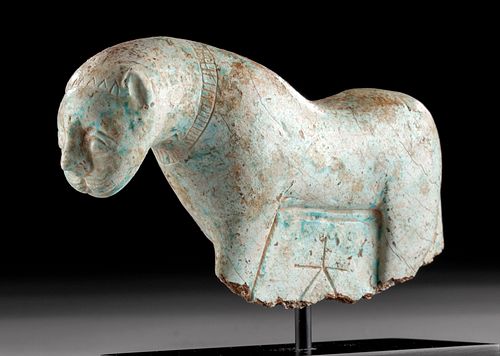Incredible Phoenician Glazed Steatite Feline w/ Ankh
Lot 63
About Seller
Artemis Gallery
686 S Taylor Ave, Ste 106
Louisville, CO 80027
United States
Selling antiquities, ancient and ethnographic art online since 1993, Artemis Gallery specializes in Classical Antiquities (Egyptian, Greek, Roman, Near Eastern), Asian, Pre-Columbian, African / Tribal / Oceanographic art. Our extensive inventory includes pottery, stone, metal, wood, glass and textil...Read more
Categories
Estimate:
$12,000 - $18,000
Absentee vs Live bid
Two ways to bid:
- Leave a max absentee bid and the platform will bid on your behalf up to your maximum bid during the live auction.
- Bid live during the auction and your bids will be submitted real-time to the auctioneer.
Bid Increments
| Price | Bid Increment |
|---|---|
| $0 | $25 |
| $300 | $50 |
| $1,000 | $100 |
| $2,000 | $250 |
| $5,000 | $500 |
| $10,000 | $1,000 |
| $20,000 | $2,500 |
| $50,000 | $5,000 |
| $100,000 | $10,000 |
| $200,000 | $20,000 |
About Auction
By Artemis Gallery
Feb 13, 2020
Set Reminder
2020-02-13 10:00:00
2020-02-13 10:00:00
America/New_York
Bidsquare
Bidsquare : Exceptional Antiquities, Asian, Ethnographic
https://www.bidsquare.com/auctions/artemis-gallery/exceptional-antiquities-asian-ethnographic-4848
An important one-day auction featuring museum-worthy examples of Egyptian, Greek, Roman, Etruscan, Near Eastern, Far East / Asian, Pre-Columbian, African / Tribal, Oceanic, Native American, Spanish Colonial, Russian, Fossils, Ancient Jewelry, Fine Art, so much more! Artemis Gallery info@artemisgallery.com
An important one-day auction featuring museum-worthy examples of Egyptian, Greek, Roman, Etruscan, Near Eastern, Far East / Asian, Pre-Columbian, African / Tribal, Oceanic, Native American, Spanish Colonial, Russian, Fossils, Ancient Jewelry, Fine Art, so much more! Artemis Gallery info@artemisgallery.com
- Lot Description
Ancient Eastern Mediterranean, Phoenicia, ca. 6th to 4th century BCE. A beautiful, incredibly rare white steatite carving of a lion, glazed with a pale, sky blue pigment. The lion is carved in the Egyptian style and the upper half of an ankh beside a Bennu bird (symbol of Osiris) shown in profile, both incised into the thin panel that fills the space between the lion's legs, further highlight the Egyptian influence on the artist and Phoenician culture in general during this time period. The other side of the body has a five-pointed star incised into the same space - also an Egyptian hieroglyph, representing "star". The legs and this panel presumably once connected to an integrated stand for what was likely a votive figure, made to be kept in a home on an altar or occasionally carried for protection. Size: 4.55" W x 2.5" H (11.6 cm x 6.4 cm); 3.5" H (8.9 cm) on included custom stand.
The lion's head has a graceful downward curve and incised lines form a narrow mane around the neck and forehead; the eyes are large, the snout almost anthropomorphic, with relief whiskers on the muzzle. The rest of the body is equally graceful and powerful, with a dip in the lower back and a broad tail that hangs down between the back legs.
Provenance: private East Coast, USA collection, purchased 10 years ago from Ancient Resource Auctions, Montrose, California, USA; ex-Lady Chelsea Hamlyn collection, London, UK, 1970s
All items legal to buy/sell under U.S. Statute covering cultural patrimony Code 2600, CHAPTER 14, and are guaranteed to be as described or your money back.
A Certificate of Authenticity will accompany all winning bids.
We ship worldwide and handle all shipping in-house for your convenience.
#153265Legs are lost at the knee; otherwise in lovely condition for its age. Rich deposits and patina on surface as shown, with nice remaining glaze. Details and form well preserved.Condition
- Shipping Info
-
All shipping is handled in-house for your convenience. Your invoice from Artemis Gallery will include shipping calculation instructions. If in doubt, please inquire BEFORE bidding for estimated shipping costs for individual items.
-
- Buyer's Premium



 EUR
EUR CAD
CAD AUD
AUD GBP
GBP MXN
MXN HKD
HKD CNY
CNY MYR
MYR SEK
SEK SGD
SGD CHF
CHF THB
THB














